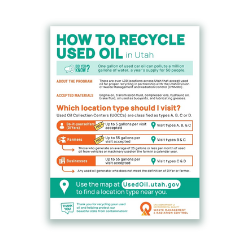Frequently Asked Questions
What is meant by “household DIYer”?
A household DIYer is a “do-it-yourself” oil changer –any person who changes the oil in their own vehicles or other engines.
Why is a special program to collect this oil necessary?
The U.S. EPA estimates that 50% of Americans change their own oil and only 35% of that oil is getting into the recycling stream. This means that some 200 million gallons of this oil is being disposed of improperly in the U.S. every year – an estimated two million gallons in Utah alone.
This causes two problems. First, disposed of in sewers, storm drains, landfills or just dumped on the ground, there is great damage to the environment and it is very expensive to clean up. Second, it is a huge waste of a non-renewable resource. Used oil has many valuable uses.
What is Utah doing about this problem?
Since 1993 it has been unlawful to dispose of oil in landfills, sewers, storm drains or on the ground, even as weed or dust depressant.
To fund a program to take care of this oil, the Utah Legislature imposed a user fee on lubricating oil of four cents a quart that is collected by oil retailers and deposited in a fund for establishing collection centers, educating the public and other facets of this program.
What is required to become a household DIYer used oil collection center?
The prospective center must complete an “Application for Registration of Used Oil Collection Center” form, give evidence of a valid business license, provide an emergency spill containment plan, have a secure location for a storage tank, and comply with the regulations covering such an establishment.
What help does the state provide for collection centers?
The Used Oil Program provides storage tanks, stairs and containment. They also provide a listing of collections centers on their website for the public.
What oils are accepted?
The general answer is used motor oil, hydraulic oils and transmission fluids. These oils should not be contaminated.
What happens if liquids that are contaminated are brought to a household DIYer center?
If the oil contains a little antifreeze, it can be accepted and placed in the holding tank. If it is largely antifreeze, it should be taken back home by the household DIYer. The household DIYer should contact the local health department to find out how he/she should properly dispose of antifreeze. You can also contact earth911.org for a list of drop-off locations.
If unacceptable oil is identified, the collection center should set it aside, not mixing it in the holding tank, and alert the local health department which will assist in either neutralizing it or otherwise getting rid of it safely.
Are there limits to how much oil a household DIYer collection center can accept?
Yes! A person who changes the oil in his or her own vehicles at home may bring up to five gallons of oil to the facility at any one time. A small farmer, one which generates no more than an average of 25 gallons of used oil a month, may bring up to 55 gallons of used oil to the center at one time. Since a 55-gallon drum is often difficult to handle, farmers are encouraged to bring their oil in smaller amounts for convenient handling. However, some collection centers have pumps which can be used to transfer this oil to the center’s storage tank.
Larger farming operations and other commercial operations which generate used oil should contact a permitted used oil transporter. A list is located on our website at www.deq.utah.gov.
What is the procedure for accepting used oil?
Individuals bringing used oil to a collection center should notify an employee once they arrive. The employee will receive the used oil and determine its suitability for recycling. If suitable, the employee will pour the used oil into the holding tank.
Each person who brings in used oil is required to complete an online survey listing their last name, zip code, and the amount of used oil delivered. This information will be used as the basis for compensating household DIYer collection centers for the used oil they collect.
How are household DIYer collection centers compensated for their efforts?
From the funds raised through a user fee of 4 cents a quart, the household DIYer center operator is paid 25 cents a gallon based on the amounts collected in that center. In addition, many collection centers like to provide this public service and the extra traffic that is built in their operation as a result of the program.
How successful is the program?
There are now more than 400 household DIYer collection centers with representation in every part of the state. As the educational programs are implemented, the amount of oil collected increases dramatically; expanding in some areas as much as five times in a single year. In the recent year for which we have completed records, there was about 400,000 gallons of this oil collected through these household DIYer collection centers.
Contact
For more information about the Used Oil Program, please contact Ted Sonnenburg ([email protected]), (385) 499-0980.

